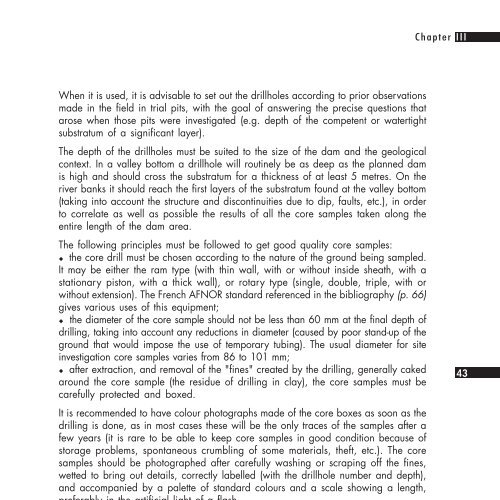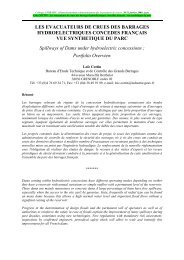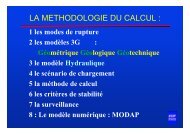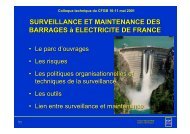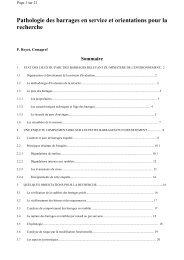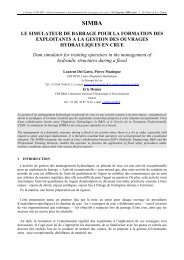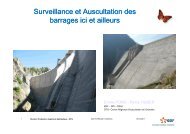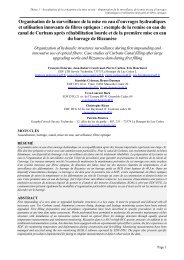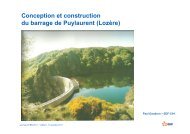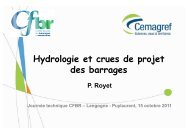SMALL DAMS
SMALL DAMS - Comité Français des Barrages et Réservoirs
SMALL DAMS - Comité Français des Barrages et Réservoirs
- No tags were found...
You also want an ePaper? Increase the reach of your titles
YUMPU automatically turns print PDFs into web optimized ePapers that Google loves.
Chapter III<br />
When it is used, it is advisable to set out the drillholes according to prior observations<br />
made in the field in trial pits, with the goal of answering the precise questions that<br />
arose when those pits were investigated (e.g. depth of the competent or watertight<br />
substratum of a significant layer).<br />
The depth of the drillholes must be suited to the size of the dam and the geological<br />
context. In a valley bottom a drillhole will routinely be as deep as the planned dam<br />
is high and should cross the substratum for a thickness of at least 5 metres. On the<br />
river banks it should reach the first layers of the substratum found at the valley bottom<br />
(taking into account the structure and discontinuities due to dip, faults, etc.), in order<br />
to correlate as well as possible the results of all the core samples taken along the<br />
entire length of the dam area.<br />
The following principles must be followed to get good quality core samples:<br />
!"the core drill must be chosen according to the nature of the ground being sampled.<br />
It may be either the ram type (with thin wall, with or without inside sheath, with a<br />
stationary piston, with a thick wall), or rotary type (single, double, triple, with or<br />
without extension). The French AFNOR standard referenced in the bibliography (p. 66)<br />
gives various uses of this equipment;<br />
!"the diameter of the core sample should not be less than 60 mm at the final depth of<br />
drilling, taking into account any reductions in diameter (caused by poor stand-up of the<br />
ground that would impose the use of temporary tubing). The usual diameter for site<br />
investigation core samples varies from 86 to 101 mm;<br />
!"after extraction, and removal of the "fines" created by the drilling, generally caked<br />
around the core sample (the residue of drilling in clay), the core samples must be<br />
carefully protected and boxed.<br />
It is recommended to have colour photographs made of the core boxes as soon as the<br />
drilling is done, as in most cases these will be the only traces of the samples after a<br />
few years (it is rare to be able to keep core samples in good condition because of<br />
storage problems, spontaneous crumbling of some materials, theft, etc.). The core<br />
samples should be photographed after carefully washing or scraping off the fines,<br />
wetted to bring out details, correctly labelled (with the drillhole number and depth),<br />
and accompanied by a palette of standard colours and a scale showing a length,<br />
preferably in the artificial light of a flash.<br />
As the cores are taken, the geologist should take detailed records of the samples<br />
including:<br />
!" a description of the ground's lithology according to depth including all pertinent data<br />
(nature, appearance, colour, porosity, oxidation, dip of the contacts, etc.) in order to<br />
permit correlations with neighbouring drillholes. This is accompanied by a drawing in a<br />
log, using a symbolic representation of the samples' nature, if possible a standard one;<br />
!"if necessary, the depth of the lower limit of the oxidation zone. This corresponds to<br />
the presence of metal oxides at the surfaces of cracks and joints, whether these come<br />
from deposits or weathering in situ (this limit generally coincides with the level of flow<br />
of surface waters and therefore with the lower limit of the decompressed zone below<br />
which cracks can be considered as tight);<br />
43


